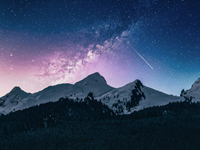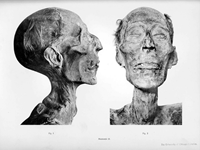From our cosmic backyard in the solar system to distant galaxies near the dawn of time, NASA's James Webb Space Telescope has fulfilled its promise to reveal the universe as never before in its first year of science operations. To celebrate the completion of a successful first year, NASA has released an image of a small star formation region in Webb's Rho Ophiuchi cloud complex.
"In just one year, the James Webb Space Telescope has changed the way humanity looks at the cosmos, peering through dust clouds and seeing light from the far corners of the universe for the first time. Each new image means a new discovery and empowers scientists around the world to ask and answer questions they once could not have imagined," said NASA Administrator Bill Nelson. "In addition to being an investment in American innovation, Webb is a scientific achievement made possible by NASA's international partners who share a can-do spirit to push the boundaries of what was known to be possible. Thousands of engineers, scientists and leaders have brought their life's passion to this mission, and their efforts will continue to advance our understanding of the origins of the universe and our place in it."
The new Webb image released today contains the closest star-forming region to us. The 390-light-year proximity of this region allows for an extremely detailed close-up with no foreground stars in the space between.
"On its first anniversary, the James Webb Space Telescope has already fulfilled its promise to reveal the universe, giving humanity a treasure trove of breathtaking imagery and science that will last for decades," said Nicola Fox, deputy administrator of NASA's Science Mission Directorate in Washington. "An engineering marvel built by the world's leading scientists and engineers, Webb has paved the way for NASA to lead the world in a new era of scientific discovery and the search for habitable worlds, giving us a more complex understanding of galaxies, stars and the atmospheres of planets outside our solar system than ever before."
Webb's image shows a region containing about 50 young stars with masses similar to or smaller than the Sun. The darkest regions are the densest, where thick dust cocoons form protostars that are still forming. Massive dipolar jets of molecular hydrogen, shown in red, dominate the image, appearing horizontally in the upper third and vertically on the right. These occur when a star first bursts through its natural envelope of cosmic dust, ejecting a pair of opposing jets into space like a newborn baby stretching its arms out to the world for the first time. In contrast, star S1 has carved a glowing dust cave in the lower half of the image. It is the only star in the image that is significantly more massive than the Sun.
"Webb's Rho Ophiuchi image allows us to witness a very short period in the life cycle of stars with new clarity. Our own Sun went through a similar phase long ago, and now we have the technology to see the beginning of another star's story," Webb said. Klaus Pontoppidan, Webb project scientist at the Space Telescope Science Institute in Baltimore, Maryland, before the telescope's launch and during the first year of operations.
Some of the stars in the image show shadows that point to protoplanetary discs - the formation of potential future planetary systems.
A FULL YEAR IN THE SKY
From its first deep-field image, unveiled live at the White House by President Joe Biden, Vice President Kamala Harris and Nelson, Webb has fulfilled its promise to show us more of the universe than ever before. But Webb has revealed much more than distant galaxies in the early universe.
"The breadth of science that Webb can explore is really becoming clear now that we have a full year of data from targets in the sky," said Eric Smith, Webb programme scientist and deputy director for research in the Astrophysics Division at NASA Headquarters. "Webb's first year of science has not only taught us new things about our universe, but also revealed that the telescope's capabilities are greater than our expectations, which means future discoveries will be even more amazing." The global astronomical community has spent the past year eagerly analysing Webb's first publicly available data and gaining insight into how to work with it.
Beyond the stunning infrared images, what really excites scientists are Webb's clear spectra - the detailed information that can be extracted from light by the telescope's spectroscopic instruments. Webb's spectra have confirmed the distances of some of the most distant galaxies ever observed and discovered the oldest, most distant supermassive black holes. They have described the compositions (or lack thereof) of planetary atmospheres in more detail than ever before, narrowing down for the first time what kinds of atmospheres might exist on rocky exoplanets. They also revealed the chemical structure of stellar nurseries and protoplanetary discs, detecting water, organic carbon-containing molecules and more. Webb observations have already resulted in hundreds of scientific papers answering long-standing questions and raising new ones to be addressed with Webb.
The breadth of Webb's science is also evident in its observations of the most familiar region of space: our own solar system. The faint rings of gas giants, dotted with moons, emerge out of the darkness, while Webb shows distant galaxies in the background. By comparing the water and other molecules detected in our solar system with those found in the discs of other, much younger planetary systems, Webb is helping to build clues about our own origins - how Earth became the ideal place for life as we know it.
"With a year of science under our belts, we know how powerful this telescope is and that it has delivered a year of spectacular data and discoveries," said Webb Senior Project Scientist Jane Rigby of NASA's Goddard Space Flight Centre. "We have chosen an ambitious set of observations for year two that builds on everything we have learnt so far. Webb's science mission is just getting started - there's still so much more to do."
Source: https://www.nasa.gov/


 Nielawore
Nielawore










Yorum yazmak için lütfen giriş yapınız